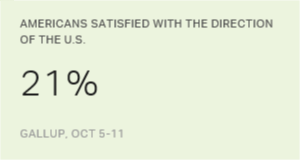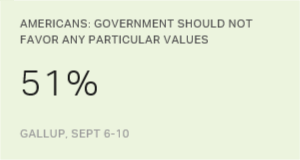Story Highlights
- 21% of Americans are satisfied with the way things are going in the U.S.
- Lowest U.S. satisfaction reading in more than a year
- Government dissatisfaction remains the top-cited U.S. problem
WASHINGTON, D.C. -- Americans' satisfaction with the way things are going in the U.S. has fallen to 21%, the lowest point since July 2016. Dissatisfaction with the government remains at the top of the list of most important problems in the country.

Gallup has been tracking the nation's mood since 1979, and the latest results are from an Oct. 5-11 poll. While readings on this measure have fluctuated throughout the years, Americans have been dissatisfied with the direction of the country for over 13 years, with less than a majority of U.S. adults saying they are satisfied since January 2004.
The current 21% satisfaction/75% dissatisfaction readings are bleak, yet they are far from the worst to date. Those were recorded in October 2008, when satisfaction dropped to 7% and dissatisfaction was nearly unanimous at 91% following Congress' authorization of the Troubled Asset Relief Program to deal with the financial crisis. The highest satisfaction reading, 71%, was recorded in February 1999 during the dot-com boom.
Past polling has shown a sizable partisan split on this question. Currently, 38% of Republicans, 11% of Democrats and 20% of independents are satisfied with the direction of the country. Republicans' satisfaction -- which showed the expected spike after Republican President Donald Trump took office -- has fallen from 55% in February, with most of the decline occurring by June.

Gallup Analytics
Subscribe to our online platform and access nearly a century of primary data.
Government Remains Most Important Problem
Americans continue to cite dissatisfaction with the government above all other issues as the United States' top problem. Government -- representing a wide array of complaints about the federal government -- has been at or near the top of the list for the past nine years. Unification of the country, which goes along with government dissatisfaction, has edged up recently, and the percentage of Americans citing race relations has doubled since August. As the immigration debate has faded from the news in recent weeks, so too has the issue from the list of top problems; healthcare is also down significantly since the summer. Gun control has edged up since the mass shooting in Las Vegas on Oct. 1, yet not as much as it has in the past following other mass shootings.
| August 2017 | September 2017 | October 2017 | |||||||||||||||||||||||||||||||||||||||||||||||||||||||||||||||||||||||||||||||||||||||||||||||||
|---|---|---|---|---|---|---|---|---|---|---|---|---|---|---|---|---|---|---|---|---|---|---|---|---|---|---|---|---|---|---|---|---|---|---|---|---|---|---|---|---|---|---|---|---|---|---|---|---|---|---|---|---|---|---|---|---|---|---|---|---|---|---|---|---|---|---|---|---|---|---|---|---|---|---|---|---|---|---|---|---|---|---|---|---|---|---|---|---|---|---|---|---|---|---|---|---|---|---|---|
| % | % | % | |||||||||||||||||||||||||||||||||||||||||||||||||||||||||||||||||||||||||||||||||||||||||||||||||
| Dissatisfaction with government | 20 | 18 | 20 | ||||||||||||||||||||||||||||||||||||||||||||||||||||||||||||||||||||||||||||||||||||||||||||||||
| Race relations/Racism | 7 | 12 | 14 | ||||||||||||||||||||||||||||||||||||||||||||||||||||||||||||||||||||||||||||||||||||||||||||||||
| Unifying the country | 6 | 8 | 11 | ||||||||||||||||||||||||||||||||||||||||||||||||||||||||||||||||||||||||||||||||||||||||||||||||
| Healthcare | 17 | 6 | 7 | ||||||||||||||||||||||||||||||||||||||||||||||||||||||||||||||||||||||||||||||||||||||||||||||||
| Situation in North Korea | 4 | 6 | 5 | ||||||||||||||||||||||||||||||||||||||||||||||||||||||||||||||||||||||||||||||||||||||||||||||||
| Economy in general | 6 | 6 | 5 | ||||||||||||||||||||||||||||||||||||||||||||||||||||||||||||||||||||||||||||||||||||||||||||||||
| Immigration | 7 | 11 | 5 | ||||||||||||||||||||||||||||||||||||||||||||||||||||||||||||||||||||||||||||||||||||||||||||||||
| Unemployment/Jobs | 7 | 4 | 5 | ||||||||||||||||||||||||||||||||||||||||||||||||||||||||||||||||||||||||||||||||||||||||||||||||
| Lack of respect for each other | 3 | 2 | 4 | ||||||||||||||||||||||||||||||||||||||||||||||||||||||||||||||||||||||||||||||||||||||||||||||||
| Crime/Violence | 3 | 3 | 4 | ||||||||||||||||||||||||||||||||||||||||||||||||||||||||||||||||||||||||||||||||||||||||||||||||
| Guns/Gun control | <1 | <1 | 4 | ||||||||||||||||||||||||||||||||||||||||||||||||||||||||||||||||||||||||||||||||||||||||||||||||
| Issues mentioned by at least 4% of respondents in October 2017 are shown. | |||||||||||||||||||||||||||||||||||||||||||||||||||||||||||||||||||||||||||||||||||||||||||||||||||
| GALLUP | |||||||||||||||||||||||||||||||||||||||||||||||||||||||||||||||||||||||||||||||||||||||||||||||||||
Bottom Line
The national mood has been persistently gloomy for more than a decade, and it has worsened in recent months. The public is frustrated with the government and its leaders, as well as generally dissatisfied with the direction of the country. After Trump's election, Republicans' increased optimism boosted the overall national mood. However, that is no longer the case, as their satisfaction has diminished over the course of 2017 -- and they too are now broadly dissatisfied with the way things are going in the U.S.
Survey Methods
Results for this Gallup poll are based on telephone interviews conducted Oct. 5-11, 2017, with a random sample of 1,028 adults, aged 18 and older, living in all 50 U.S. states and the District of Columbia. For results based on the total sample of national adults, the margin of sampling error is ±4 percentage points at the 95% confidence level. All reported margins of sampling error include computed design effects for weighting.
Each sample of national adults includes a minimum quota of 70% cellphone respondents and 30% landline respondents, with additional minimum quotas by time zone within region. Landline and cellular telephone numbers are selected using random-digit-dial methods.
View survey methodology, complete question responses and trends.
Learn more about how the Gallup Poll Social Series works.




